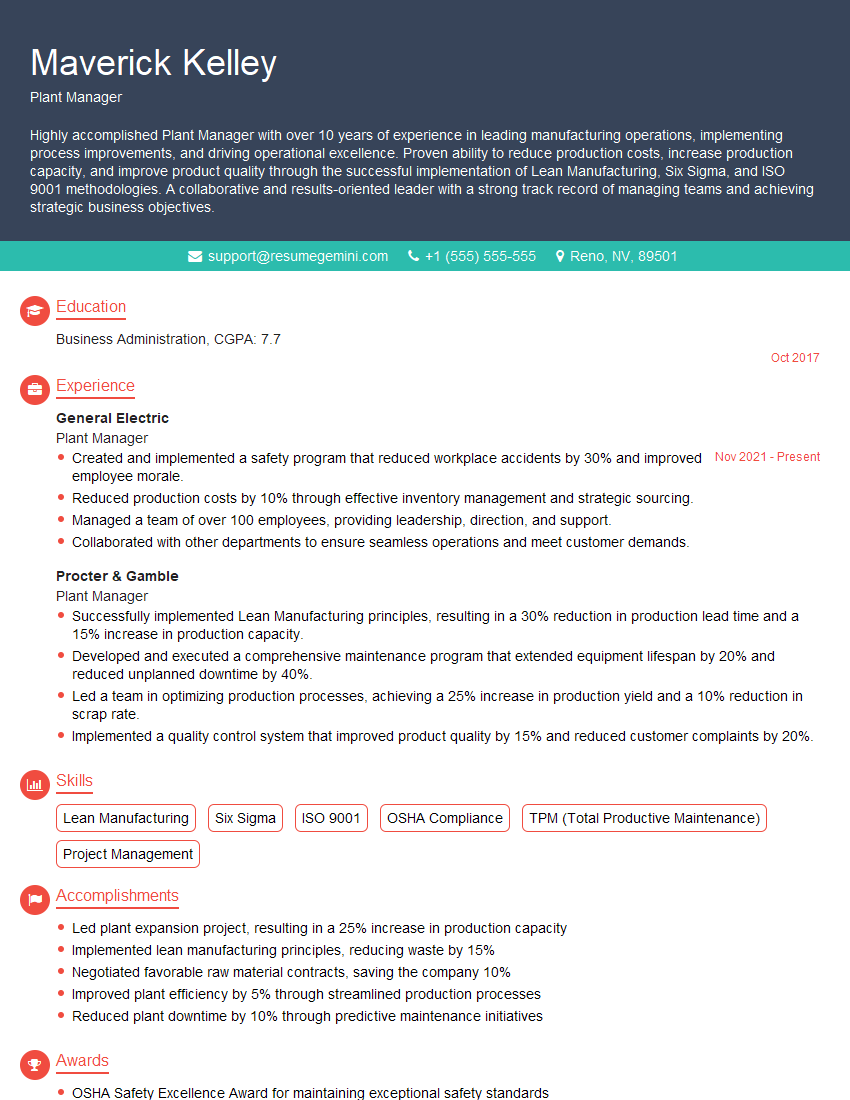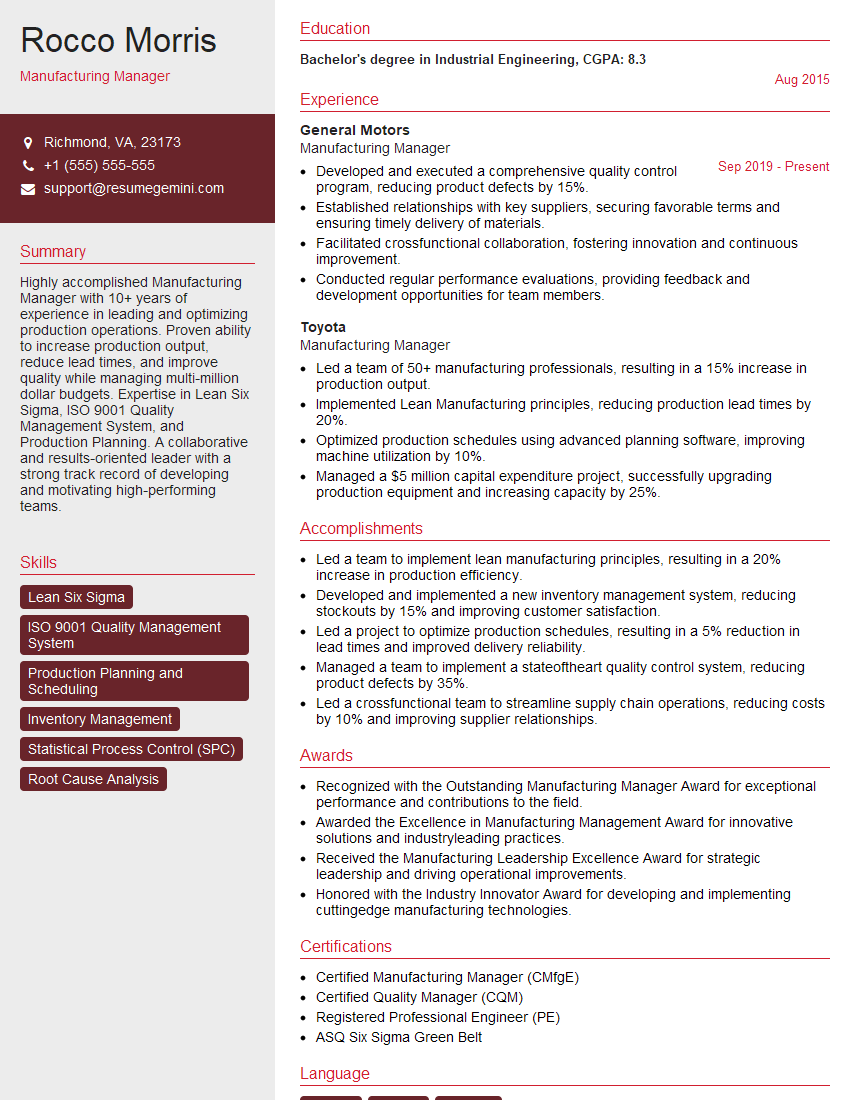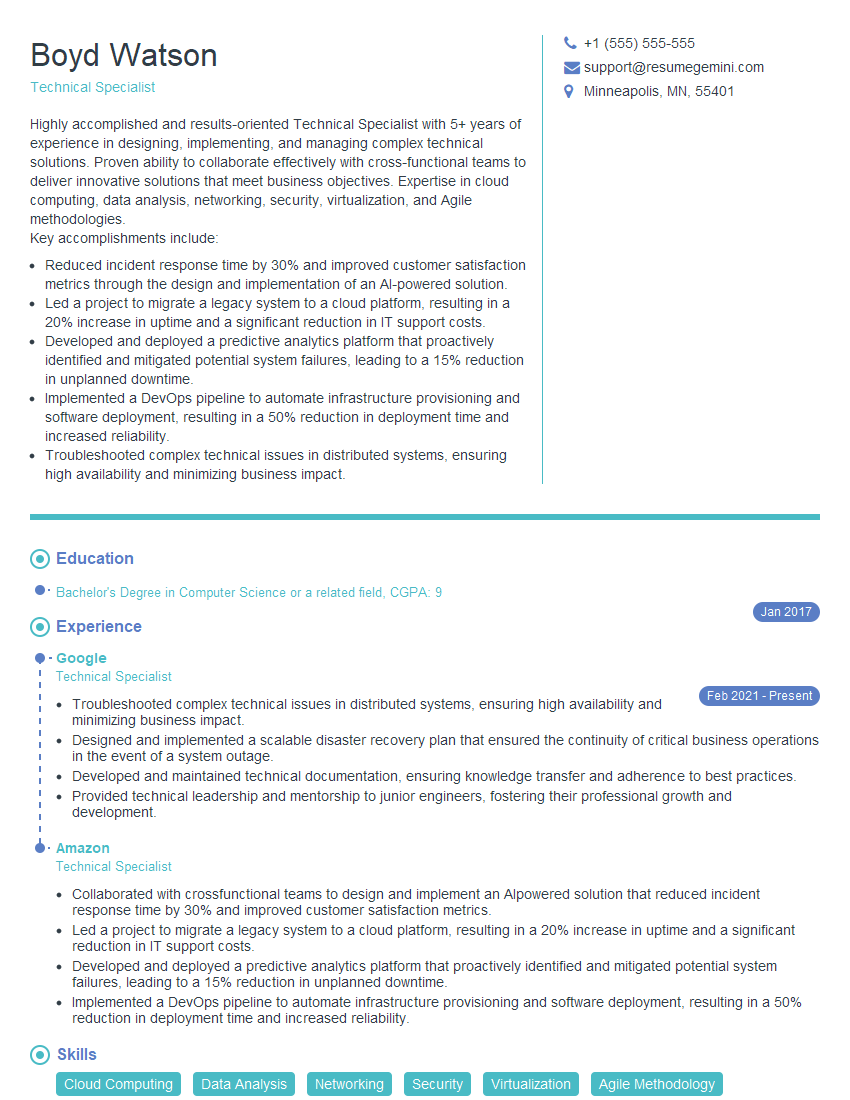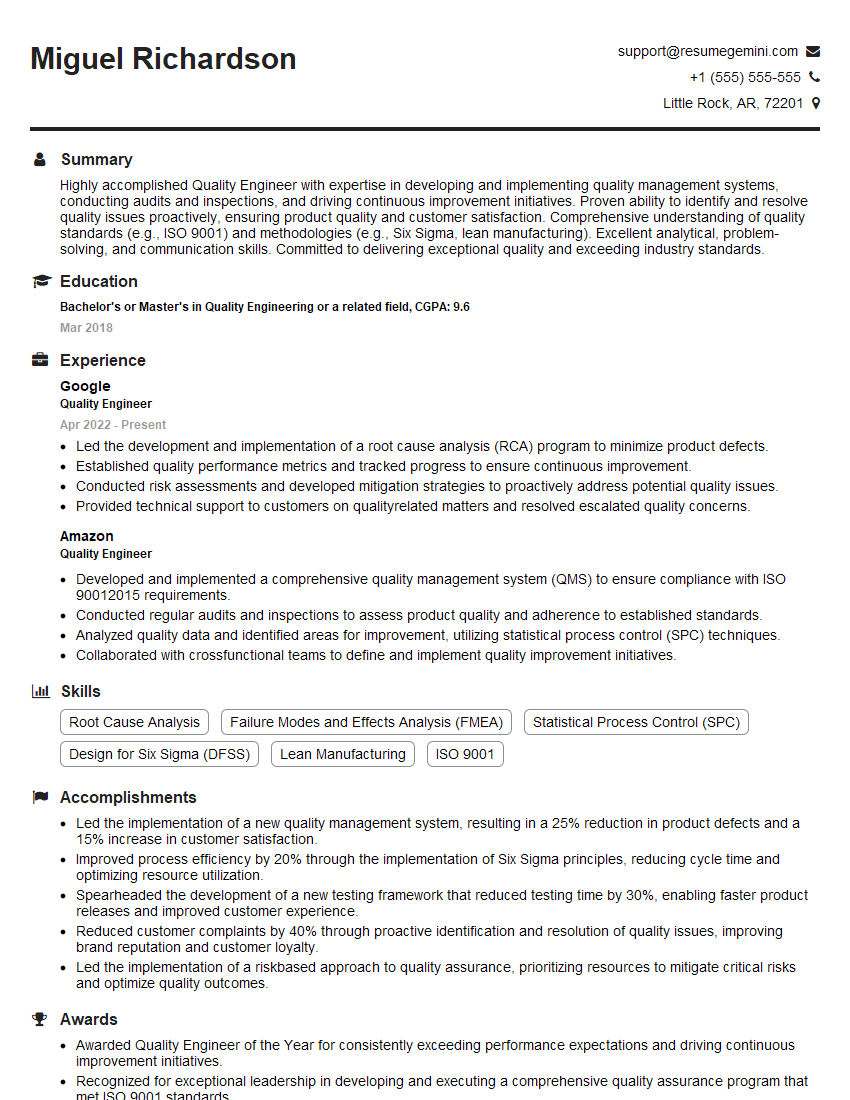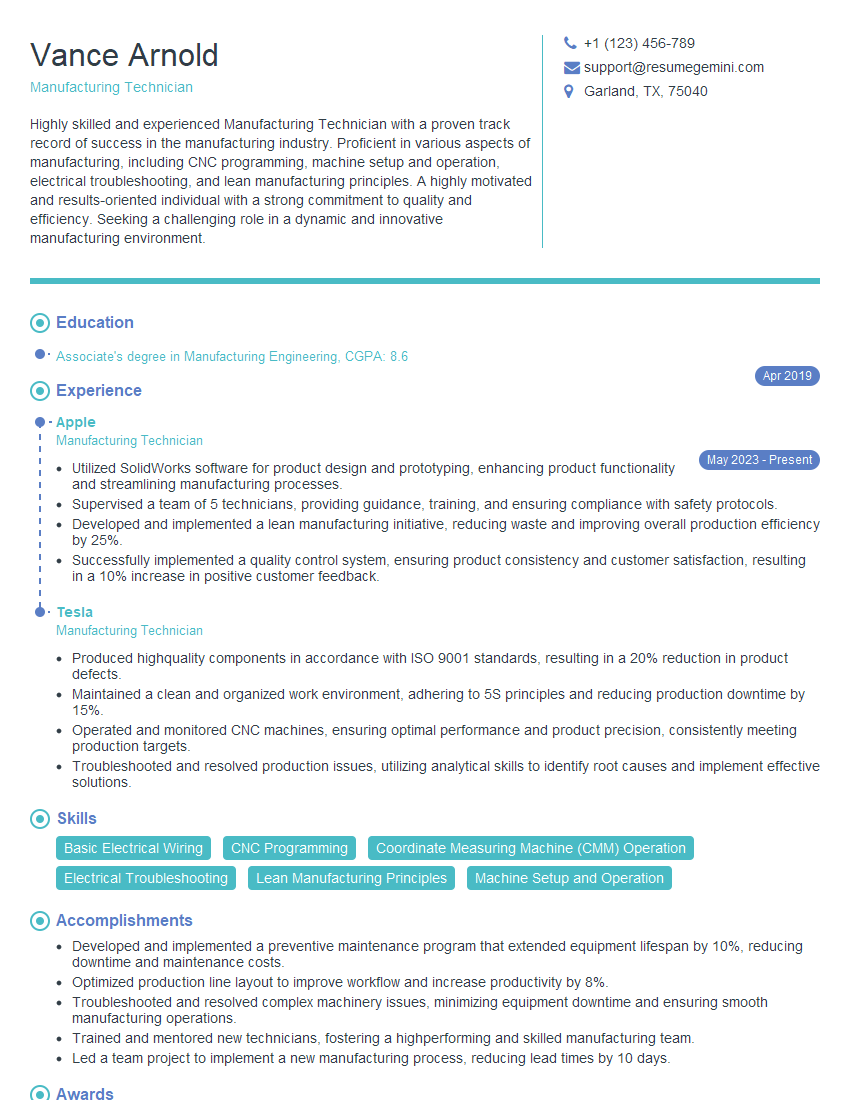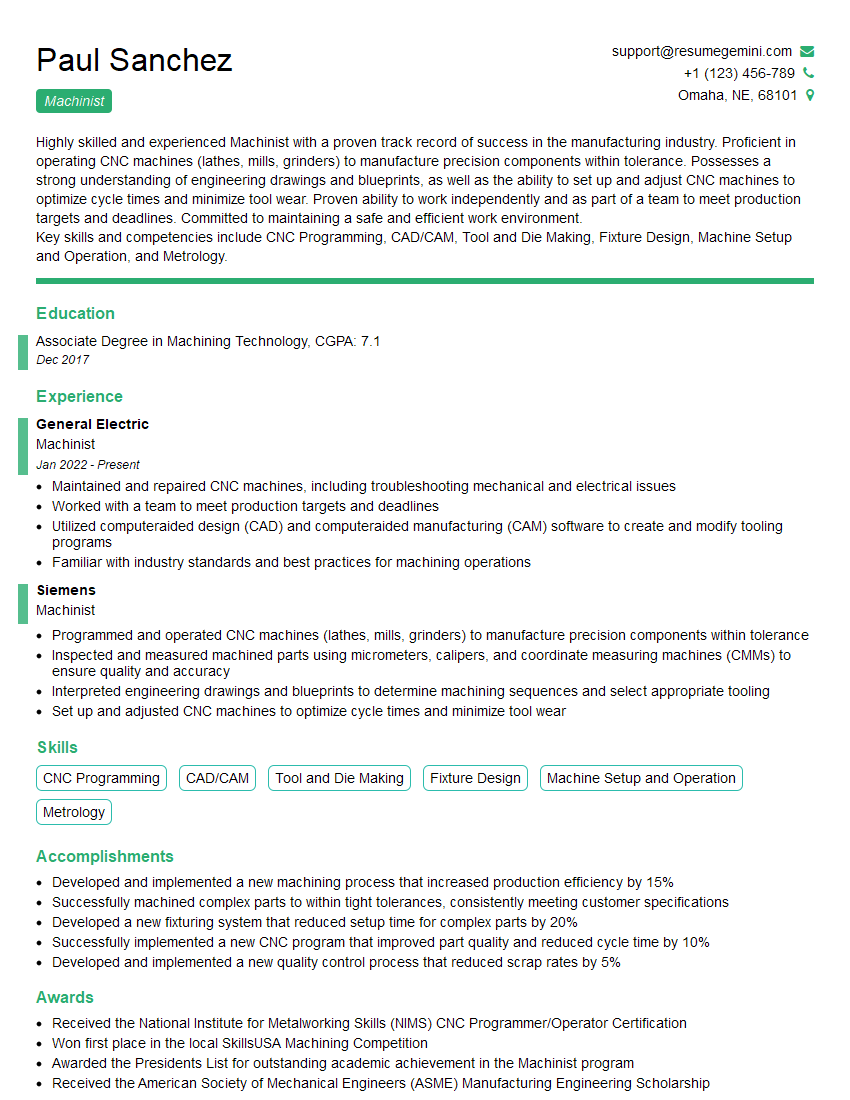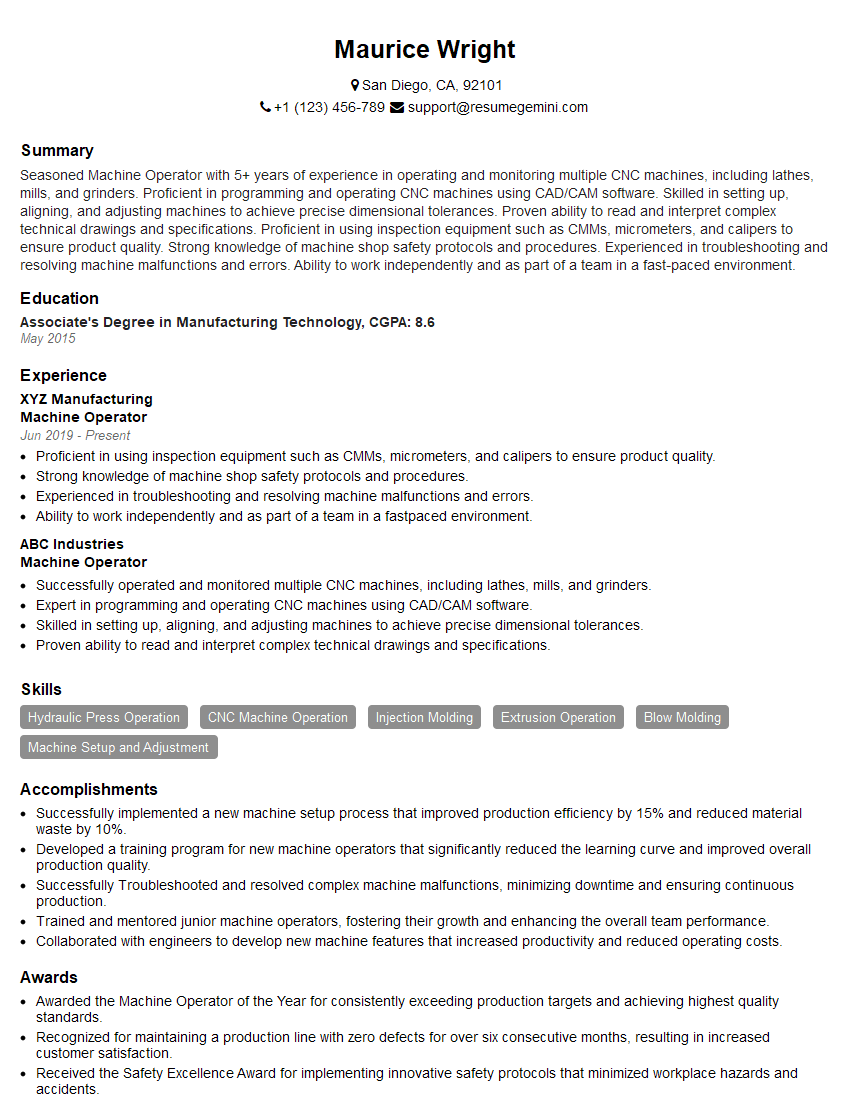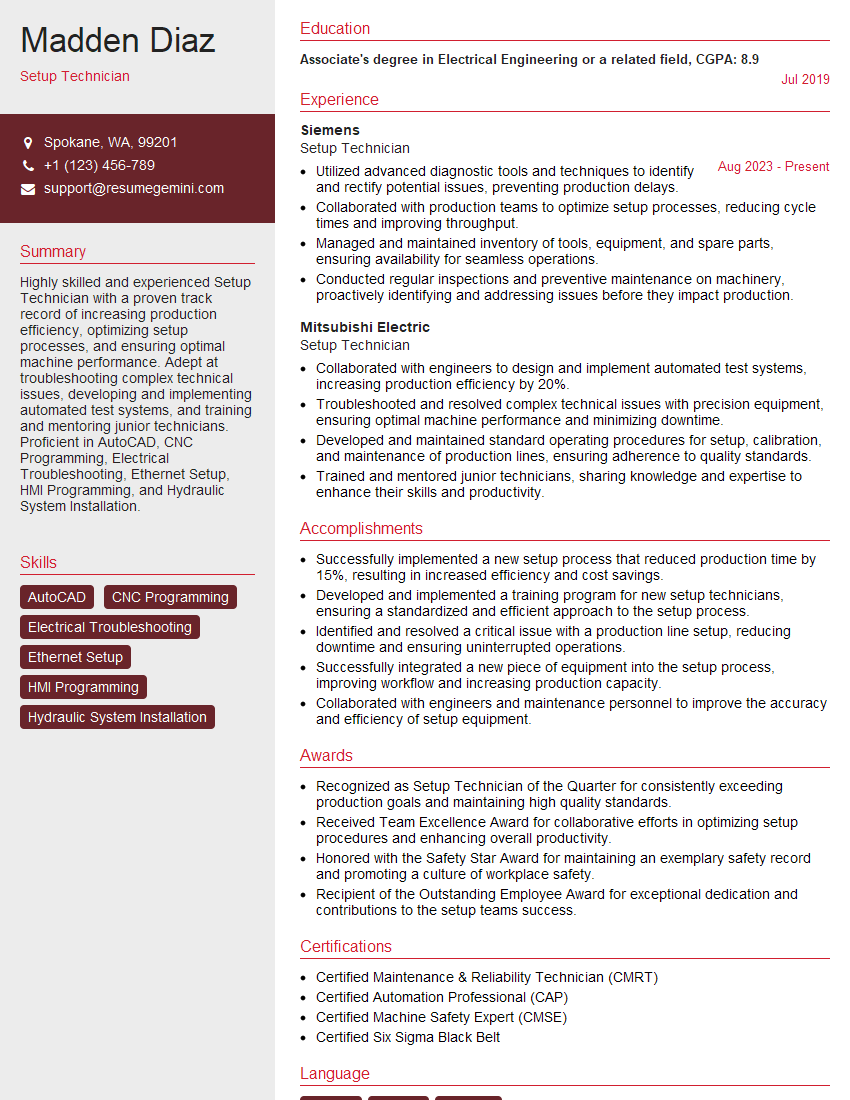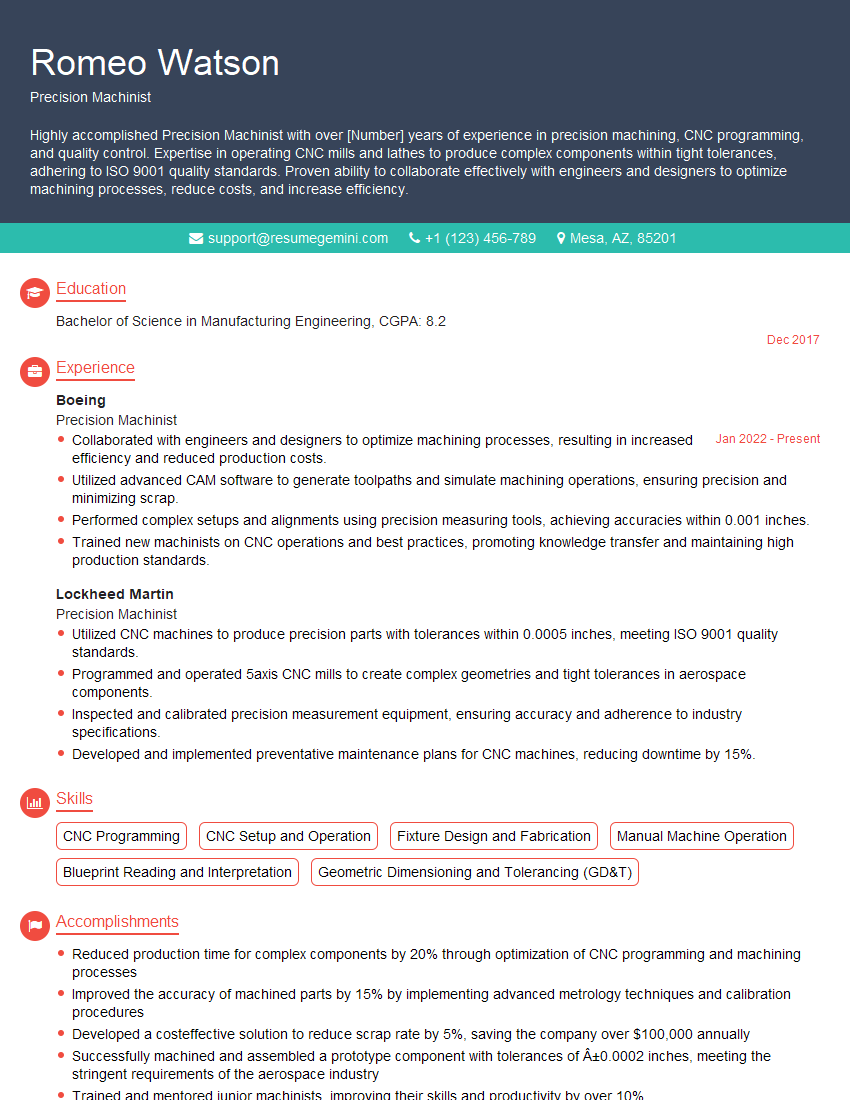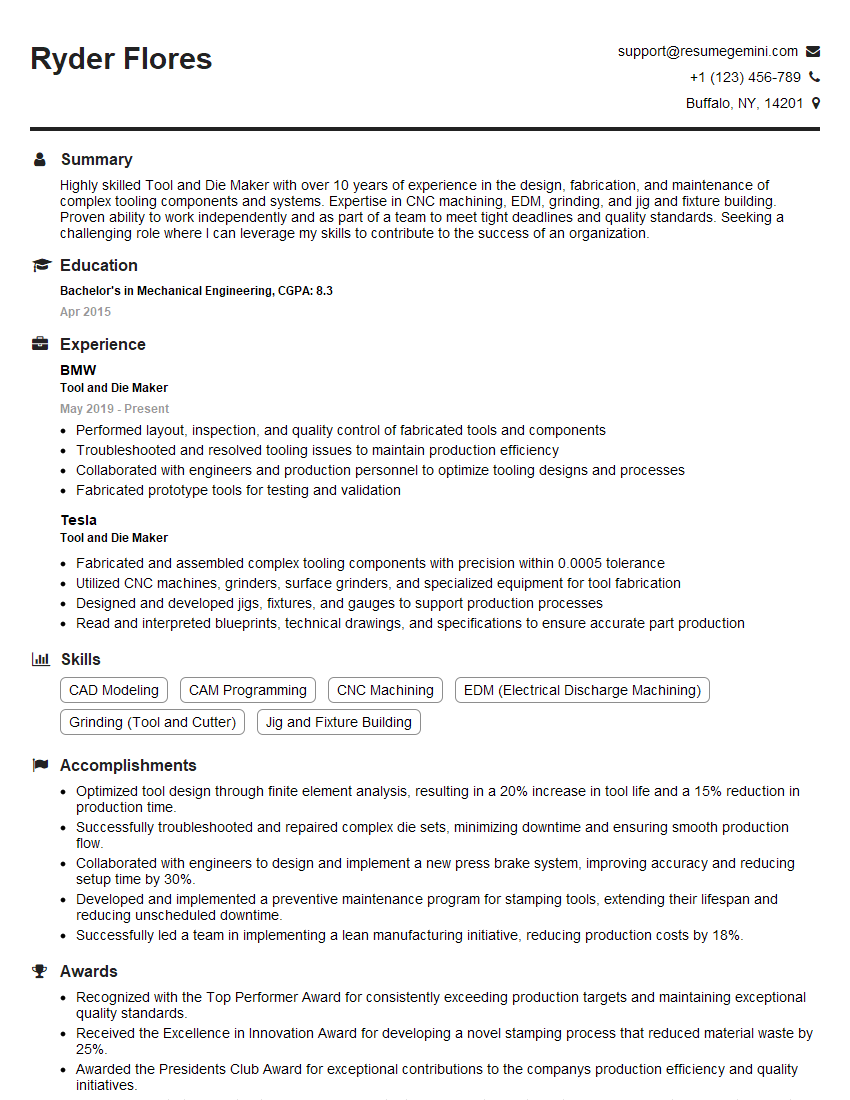Feeling uncertain about what to expect in your upcoming interview? We’ve got you covered! This blog highlights the most important Metal Tapping interview questions and provides actionable advice to help you stand out as the ideal candidate. Let’s pave the way for your success.
Questions Asked in Metal Tapping Interview
Q 1. Explain the process of metal tapping.
Metal tapping is a machining process used to create internal threads in a workpiece. Imagine it like screwing a screw into a piece of metal, but instead of pre-existing threads, you’re creating them from scratch. This is done using a tap, a precisely engineered cutting tool with helical grooves that progressively cut material away as it’s rotated, forming the threads. The process requires careful control of speed, feed rate, and lubrication to ensure clean, accurate threads and prevent tap breakage.
The process typically involves three steps:
- Spotting: A small pilot hole is drilled, slightly smaller than the tap’s root diameter, to ensure accurate thread alignment and prevent tap breakage.
- Tapping: The tap is inserted into the pilot hole and carefully rotated, either manually or using a tapping machine. The tap’s cutting edges remove material, forming the threads. This is usually done in multiple passes using different taps (explained in the next answer).
- Deburring (Optional): Once the tapping is complete, any burrs or sharp edges on the threads are removed using a deburring tool. This is important for preventing damage to mating parts and improving overall thread quality.
Q 2. What are the different types of taps used in metal tapping?
Taps come in various types, categorized primarily by the number of passes required to create a complete thread:
- Hand Tap Sets (3-piece): These sets are used for manual tapping and consist of a taper tap (for starting and creating the initial threads), an intermediate tap (for further thread formation), and a bottoming tap (for reaching the full depth of the thread). The taper tap starts the cutting process more easily because its flutes are tapered to start from a smaller diameter and reduce the force needed to engage with the material. The intermediate tap is more aggressive and continues cutting. The bottoming tap has the largest diameter, extending the thread all the way through to the bottom of the hole.
- Machine Taps: These are designed for use with tapping machines and are usually more robust, allowing for higher speed and efficiency. Common types include spiral point and spiral flute taps, which we’ll explore further in a later answer.
- Plug Taps: These taps create threads to a depth slightly less than the full length of the tap, leaving a small unthreaded portion at the bottom. These are widely used and are a good choice for general-purpose tapping.
- Bottoming Taps: As the name indicates, these taps create threads all the way to the bottom of the hole. They are stronger and require more torque than plug taps but are essential when the full depth is needed.
Choosing the correct tap set is crucial for achieving clean, consistent threads. Incorrectly sized or used tap can lead to breakage or poor thread quality.
Q 3. Describe the various tap materials and their applications.
Taps are typically made from high-strength materials to withstand the rigors of cutting metal. The choice of material depends on the application and the material being tapped.
- High-Speed Steel (HSS): This is the most common material for taps. It offers a good balance of strength, hardness, and toughness, making it suitable for a wide range of applications. HSS taps are widely used for materials such as aluminum, steel, and cast iron.
- High-Speed Steel with Titanium Nitride (TiN) Coating: The TiN coating enhances wear resistance and reduces friction, resulting in longer tap life and improved surface finish. This is an excellent choice for tougher materials or high-volume production.
- Carbide: Carbide taps are significantly harder and more wear-resistant than HSS taps and are ideal for tapping very hard materials or for applications where high precision and long tap life are crucial. This is often the choice for work on stainless steels and super alloys.
- Powder Metallurgy (PM) HSS: This material provides superior durability and resistance to breakage. PM HSS taps are commonly used when tapping tougher materials and increased tap life is a critical requirement.
The selection of tap material directly impacts cost, durability, and overall quality of the produced threads. For instance, carbide taps, while expensive, would be a better investment for high-volume production tapping of hardened steel, whereas HSS taps would be suitable for general-purpose tapping of softer materials like aluminum.
Q 4. How do you select the correct tap size for a given application?
Selecting the correct tap size is critical for successful tapping. The tap size must match the thread size specified on the blueprint or drawing of the component. This usually includes the diameter and threads per inch (TPI) or metric pitch.
You need to consider these factors:
- Nominal Diameter: The diameter of the tap, corresponding to the specified thread size.
- Threads Per Inch (TPI) or Metric Pitch: The number of threads per inch (for inch-based systems) or the distance between adjacent threads (for metric systems). This must exactly match the specified design thread pitch.
- Material Being Tapped: The material’s hardness and toughness influence the tap’s selection. Harder materials require tougher and harder taps.
- Type of Tap: Hand tap sets, machine taps, or plug and bottoming taps should be selected based on the operation and desired thread depth.
Always reference engineering drawings and specifications. Using the wrong tap size can lead to stripped threads, tap breakage, or a complete failure of the assembly.
Q 5. What are the different tap styles (e.g., spiral point, spiral flute)?
Tap styles influence cutting efficiency and the quality of the resulting threads. The most common styles are:
- Spiral Point Taps: These taps have a pointed end with spiral flutes. The spiral point helps center the tap, facilitating easier starting and smoother cutting. They reduce the initial cutting force and are particularly useful in tough-to-machine materials or thin-walled parts. This is very useful for high-volume production and when precision is critical.
- Spiral Flute Taps: Also known as helical flute taps, these have a continuous spiral groove along their length. This design helps to clear chips more effectively, minimizing clogging and reducing friction. They are excellent for through-hole tapping or deep hole tapping, as they improve chip evacuation and prevent tap breakage.
- Straight Flute Taps: These taps have straight flutes running parallel to the tap’s axis and are more suitable for manual tapping and soft materials.
The choice of tap style is based on factors such as the material being tapped, the depth of the hole, and whether the tapping is done manually or by machine.
Q 6. Explain the importance of tap lubrication.
Tap lubrication is absolutely crucial. It’s not just about making the process easier; it directly impacts the quality of the threads, tap life, and overall efficiency. Lubricant performs several vital functions:
- Reduces Friction: The lubricant acts as a barrier between the tap and the workpiece, reducing friction and heat generated during the cutting process. This minimizes the force required for tapping and prevents tap breakage.
- Improves Chip Removal: Lubricant helps to flush chips out of the cutting area, preventing chip clogging and improving thread quality. This is particularly important in blind holes.
- Extends Tap Life: By reducing friction and wear, tap lubrication significantly extends the life of the tap.
- Enhances Thread Finish: Proper lubrication results in smoother, more accurate threads.
Common tap lubricants include cutting oils, greases, and specialized tapping fluids. The choice of lubricant depends on the material being tapped and the type of machine being used. It’s vital to use a lubricant appropriate for the work material as improper lubricant choice can even lead to negative impacts in overall tap life and thread quality.
Q 7. What are the common causes of tap breakage?
Tap breakage is a common problem in metal tapping, often caused by a combination of factors. It’s always a costly issue, demanding process redesign and replacement of tools and/or materials.
- Excessive Force: Applying too much force during tapping, especially when using manual methods, can lead to tap breakage. This might be because of incorrect machine set-up or poor operator technique.
- Insufficient Lubrication: Lack of lubrication or the use of an inappropriate lubricant increases friction and heat, making the tap more prone to breakage.
- Improper Tap Selection: Using the wrong type or size of tap can also result in breakage. A poorly matched tap and material combination, for example.
- Dull or Damaged Taps: Using a dull or damaged tap increases the force required for cutting, increasing the risk of breakage.
- Chip Clogging: Chips accumulating in the flutes can impede the tapping process and put additional stress on the tap, eventually causing it to break. This is more likely to happen in deep blind holes or poor tap selection.
- Workpiece Material Hardness: Tapping extremely hard materials without a proper tap and sufficient lubrication can be challenging and easily result in breakage.
- Improper Machine Setup: In machine tapping, incorrect speed, feed rate, or torque settings can lead to tap breakage.
Preventing tap breakage requires careful attention to detail, including proper planning, correct tap selection, adequate lubrication, and skilled operation.
Q 8. How do you prevent tap breakage?
Tap breakage is a common frustration in metalworking, often stemming from improper technique or tool selection. Preventing it requires a multi-pronged approach focusing on preparation, execution, and tool maintenance.
- Proper Lubrication: Using a cutting fluid (like tap lubricant or cutting oil) is paramount. It reduces friction, heat generation, and chip buildup, all major contributors to tap breakage. Think of it like lubricating a car engine – it makes the process smoother and prevents damage.
- Sharp Taps: Dull taps are much more likely to break. Regularly inspect your taps for damage and replace them when necessary. A dull tap struggles to cut cleanly, forcing it to work harder and increasing breakage risk.
- Correct Tap Drill Size: Using the wrong drill size leaves insufficient material for the tap to engage properly, causing stress and breakage. We’ll delve into determining the correct tap drill size later.
- Appropriate Speed and Feed: Overly aggressive tapping speeds and feeds generate excessive heat and stress. Start slow and increase as needed, monitoring for resistance. It’s a delicate balance – too slow and it’ll take forever; too fast and you’ll risk breakage.
- Stable Setup: Ensure the workpiece is securely clamped and the tapping machine (if used) is properly calibrated and maintained. Vibrations or movement during tapping can easily snap a tap.
- Material Consideration: Harder materials necessitate slower speeds and more lubrication. Always select the appropriate tap for the material being tapped.
By diligently following these steps, you can significantly reduce the chances of tap breakage and improve efficiency.
Q 9. How do you address a broken tap?
A broken tap is a significant problem, potentially requiring specialized extraction techniques. The approach depends on the extent of the breakage and accessibility.
- Easy Extraction (Tap Partially Exposed): If a portion of the tap is still visible, carefully using pliers or a tap extractor might suffice. Ensure a firm grip to avoid further damage.
- Difficult Extraction (Tap Embedded): For completely embedded or broken taps, several methods exist.
- Tap Extractors: These specialized tools are designed to grip and remove broken taps. They come in various sizes and designs. They are generally better at removing broken taps than other methods.
- Drilling and Extraction: Carefully drill a pilot hole slightly smaller than the tap’s diameter, then use a tap extractor designed for this purpose.
- EDM (Electrical Discharge Machining): For particularly stubborn cases or delicate components, EDM might be necessary. This precision machining process erodes the broken tap without damaging the surrounding material. It is a more complex and expensive method.
- Prevention is Key: The best approach to a broken tap is to prevent it from happening in the first place. Refer to the previous answer on preventative measures.
Remember safety first! Always wear appropriate eye protection and use caution when working with sharp tools or machinery.
Q 10. Explain the concept of tap drill size.
The tap drill size is the diameter of the hole you drill before tapping. It’s crucial for creating the correct thread form. The tap drill size must be smaller than the major diameter (the widest part) of the tap’s threads to leave enough material for the tap to cut threads into.
Think of it like making a screw: you need to create a hole slightly smaller than the screw’s shaft to allow the screw to cut its threads and fasten properly. If the hole is too large, the screw will be loose; if it’s too small, the screw won’t go in.
Q 11. How do you determine the correct tap drill size?
Determining the correct tap drill size is critical for a successful tapping operation. It depends on the thread size, the thread pitch (distance between adjacent threads), and the type of thread (e.g., metric, Unified National Coarse [UNC], Unified National Fine [UNF]).
Several resources are available to find this information:
- Tap and Drill Charts: These readily available charts provide tap drill size recommendations for various thread sizes. They are often found in machinery catalogs or online.
- Machinist’s Handbook: This comprehensive resource contains detailed tables for tap drill sizes.
- Online Calculators: Many online calculators allow you to input thread specifications (thread diameter, pitch) to automatically calculate the tap drill size.
Example: Let’s say you need to tap a 1/4”-20 UNC thread (1/4 inch diameter, 20 threads per inch). A tap and drill chart would show the appropriate tap drill size, usually around 7/32 inch or 0.21875 inches.
Q 12. What are the different methods for tapping (e.g., hand tapping, machine tapping)?
Metal tapping can be performed using several methods, each with its own advantages and disadvantages:
- Hand Tapping: This involves manually turning a tap using a tap wrench. It’s suitable for smaller jobs and when precise control is required.
- Machine Tapping: This method uses a tapping machine to automate the process, allowing for faster and more consistent tapping, particularly useful for high-volume production.
- Power Tool Tapping (Drill Press): Using a drill press with specialized tapping attachments provides more control and speed than hand tapping, suitable for medium-sized jobs.
Q 13. Describe the advantages and disadvantages of each tapping method.
Let’s compare the advantages and disadvantages of each tapping method:
- Hand Tapping:
- Advantages: Precise control, good for small or intricate parts, lower initial investment.
- Disadvantages: Slower, more labor-intensive, susceptible to operator error.
- Machine Tapping:
- Advantages: Fast, consistent, high production rate, less operator fatigue.
- Disadvantages: Higher initial investment, less control over individual taps, may be unsuitable for small batches.
- Power Tool Tapping (Drill Press):
- Advantages: Faster than hand tapping, more control than machine tapping, suitable for a range of sizes.
- Disadvantages: Requires more setup time compared to hand tapping, potential for damage if not used properly.
Q 14. What safety precautions should be taken when performing metal tapping?
Safety is paramount when performing metal tapping. Here are crucial precautions:
- Eye Protection: Always wear safety glasses or a face shield to protect against flying chips and debris. This is non-negotiable.
- Gloves: Consider wearing work gloves to improve grip and protect your hands from cuts and abrasions.
- Proper Work Area: Ensure a clean, well-lit, and organized workspace. Clutter can lead to accidents.
- Secure Workpiece: Firmly clamp the workpiece to prevent movement during tapping. A shifting workpiece can lead to broken taps, damaged parts, or injuries.
- Machine Safety (if applicable): If using machinery, follow all manufacturer safety instructions carefully. Know the emergency stop procedures.
- Cutting Fluid Use: Always use appropriate cutting fluid to reduce friction, heat, and chip buildup, which helps prevent accidents.
- Tool Condition: Only use sharp, properly maintained taps. Dull or damaged taps increase the risk of breakage and injuries.
Remember: If you’re unsure about any aspect of the process, consult experienced professionals or refer to comprehensive instructional materials. Safety should always be your top priority.
Q 15. How do you inspect a tapped hole for quality?
Inspecting a tapped hole for quality involves several steps to ensure it meets the required specifications. This is crucial because a poorly tapped hole can compromise the strength and reliability of the entire assembly. We typically start with a visual inspection, looking for obvious defects like chips, burrs, or irregularities in the thread profile. Then we use appropriate gauging tools. For example, a thread gauge will verify that the thread size and pitch are correct. A go/no-go gauge offers a quick check confirming the hole is within tolerance. Finally, we can use a magnifying glass or even a borescope for more detailed examination of the thread’s form, especially in deeper holes or hard-to-reach areas. A feeler gauge is useful to check if the tapped hole is free from any excessive tightness or looseness.
For example, imagine tapping a hole for a critical component in an aircraft engine. A slight deviation in thread pitch or diameter could lead to catastrophic failure. Thorough inspection is therefore paramount.
Career Expert Tips:
- Ace those interviews! Prepare effectively by reviewing the Top 50 Most Common Interview Questions on ResumeGemini.
- Navigate your job search with confidence! Explore a wide range of Career Tips on ResumeGemini. Learn about common challenges and recommendations to overcome them.
- Craft the perfect resume! Master the Art of Resume Writing with ResumeGemini’s guide. Showcase your unique qualifications and achievements effectively.
- Don’t miss out on holiday savings! Build your dream resume with ResumeGemini’s ATS optimized templates.
Q 16. What are the common defects found in tapped holes?
Common defects in tapped holes stem from various issues during the tapping process. These include:
- Broken Taps: This often results in a damaged or incomplete thread.
- Stripped Threads: Caused by excessive force or improper tapping techniques, leading to damaged thread profiles.
- Poor Thread Form: Imperfect thread shape due to dull taps, incorrect cutting speeds, or excessive pressure.
- Misaligned Holes: Offset tapping produces an inconsistent and unusable thread.
- Tap Breakage: A fractured tap often leaves fragments embedded in the tapped hole.
- Chip Formation: Excessive chip formation, particularly in brittle materials, can clog the tap and damage the threads.
- Hole Diameter Errors: Tapping a hole that’s not sized correctly will create unusable threads.
Identifying these defects early in the process is essential to prevent costly rework or component failure. For instance, a stripped thread in a threaded fastener connection can lead to joint failure with potentially dangerous consequences.
Q 17. How do you measure the tap depth?
Measuring tap depth depends on the type of hole (through or blind) and the required precision. For through holes, the depth isn’t critical, but overall length and alignment are. For blind holes, we usually employ several methods:
- Depth Micrometer: A precision measuring tool is used to directly measure the depth of the hole.
- Depth Gauge: Simple, spring-loaded gauges allow quick checks of the tapped depth.
- Magnetic Base and Dial Indicator: These can be used to accurately measure the depth from a reference point.
- Optical Comparator: This method projects an enlarged image of the hole, facilitating precise depth measurement.
- Measurement from the Surface: Measuring from the top surface of the workpiece to the bottom of the threaded portion of the hole can provide an adequate approximation.
The choice of method will depend on the required accuracy, accessibility of the hole, and the tools available. In high-precision applications, such as aerospace manufacturing, using a calibrated depth micrometer is critical.
Q 18. How do you troubleshoot issues with tap alignment?
Troubleshooting tap alignment problems is crucial for creating functional and strong threaded connections. Poor alignment can result in damaged threads or an inability to assemble components correctly. Here are some strategies:
- Verify the Drilling Process: Ensure the pilot hole is accurately drilled and is perpendicular to the surface.
- Inspect the Tap Guide or Bushings: Make sure guides are correctly aligned and undamaged. They are critical for maintaining tap alignment.
- Check the Machine Setup: On CNC machines, precise alignment relies on proper setup and programming. Any misalignment in the machine’s axes must be addressed.
- Use a Drill Jig: Drill jigs provide accurate guidance to maintain alignment during drilling and tapping operations.
- Inspect Tap Condition: A bent tap will inevitably create misaligned threads. Use a straight edge or a comparator to verify tap straightness before use.
- Slow and Steady Tapping: Apply even and controlled force during tapping to mitigate alignment problems.
Imagine tapping holes on a circuit board; even a minor misalignment can damage sensitive components. Careful attention to alignment throughout the process is essential.
Q 19. Explain the difference between through-hole and blind-hole tapping.
The difference between through-hole and blind-hole tapping lies in the depth of the tapped hole. A through-hole extends completely through the workpiece, creating a passage. A blind-hole, on the other hand, stops short of the opposite side, creating a cavity with a threaded bottom. This distinction significantly impacts the tapping process and the tools used.
For through-hole tapping, the tap is simply passed through the workpiece. However, blind-hole tapping requires more control to avoid bottoming out the tap and potentially damaging it or the workpiece. Different tap styles, like spiral-point taps, are frequently used for blind holes to better manage chip evacuation and minimize breakage.
A classic example of a through-hole is a bolt hole in a chassis, while a blind-hole is commonly used for threaded inserts in a plastic housing, where the complete thread penetration isn’t needed or desired.
Q 20. How do you deal with different material hardness in tapping?
Dealing with different material hardness in tapping requires adjusting the process parameters to avoid tap breakage and ensure thread quality. Harder materials require more cautious tapping.
- Tap Material Selection: Selecting taps made from high-speed steel (HSS) or carbide for harder materials is crucial.
- Cutting Fluids: Using appropriate cutting fluids – often specifically formulated for the given material – helps reduce friction, heat, and chip formation.
- Reduced Feed Rates: Slower feed rates and cutting speeds are necessary for harder materials to prevent tap breakage and ensure cleaner threads.
- Increased Cutting Fluid Application: Abundant cutting fluid is especially important with harder materials to improve lubrication and cooling.
- Multiple Taps: Sometimes using multiple taps of increasing diameters (e.g., a roughing tap and then a finishing tap) can be beneficial to reduce stress on the tap and improve quality.
For example, tapping a hole in hardened steel requires a significantly slower speed and feed rate compared to tapping in aluminum. Ignoring this difference can lead to a broken tap or poor quality threads.
Q 21. What is the significance of tap speed and feed rate?
Tap speed and feed rate are critical parameters directly influencing the quality of the tapped hole and the lifespan of the tap. They are interrelated and must be optimized for the specific material and tap being used.
- Tap Speed (RPM): Too high a speed generates excessive heat, leading to tap wear and potential breakage. Too low a speed reduces efficiency.
- Feed Rate (IPM): This refers to the rate at which the tap advances into the workpiece. An excessively high feed rate leads to excessive pressure and can strip the threads, whereas a too-low feed rate can slow down production.
The ideal combination of tap speed and feed rate depends on factors like material hardness, tap type, and diameter. Manufacturers often provide recommendations or charts for optimal settings. For instance, tapping a brittle material requires a slower speed and feed than tapping a more ductile material. An analogy would be driving a screw: too fast and you strip the wood, too slow and it’s inefficient.
Q 22. Describe your experience with different types of tapping machines.
My experience with tapping machines spans a wide range, from simple hand taps to sophisticated CNC-controlled tapping machines. I’ve worked extensively with:
- Hand taps: Essential for small-scale jobs and hard-to-reach areas, requiring precision and feel. I’m proficient with various tap sizes and materials, understanding the nuances of applying the right pressure and technique to avoid breakage. For example, I’ve successfully hand-tapped numerous delicate components for precision instruments without damaging the workpiece.
- Power tapping heads: These are attached to drill presses or other machine tools, offering increased speed and efficiency for repetitive tasks. I’m familiar with various types, including those with adjustable torque settings and reverse capabilities for chip removal. I’ve used these extensively in manufacturing environments for high-volume production runs.
- CNC tapping machines: These provide the highest level of precision and repeatability. My experience includes programming and operating these machines, ensuring accurate hole placement and threading on complex parts. I’ve used these on projects requiring tight tolerances and intricate threading patterns, such as aerospace components.
- Automatic tapping machines: I’ve worked with machines that automatically feed and tap parts, maximizing throughput and consistency. These are crucial in high-volume production settings where minimizing downtime and ensuring uniform quality is paramount.
Understanding the capabilities and limitations of each type of machine is crucial for selecting the most appropriate tool for the job and achieving optimal results.
Q 23. How do you maintain and clean tapping tools?
Maintaining and cleaning tapping tools is crucial for their longevity and to ensure consistent, high-quality threads. My process involves:
- Cleaning: After each use, I meticulously clean the tap with a suitable solvent (like kerosene or a specialized tap cleaning solution) to remove chips and debris. This prevents clogging and ensures smooth operation. A brush can help remove stubborn material from the tap flutes.
- Inspection: I carefully inspect the tap for any signs of damage, such as chipped teeth or excessive wear. Minor damage can be addressed using a tap sharpener, while severely damaged taps should be replaced.
- Lubrication: Proper lubrication is critical. I apply a suitable tapping fluid (which varies depending on the material being tapped) to reduce friction, heat, and wear, preventing chip buildup and extending tap life. I avoid using excessive lubricant, as this can lead to poor thread formation.
- Storage: Tapping tools are stored in a clean, dry environment to prevent rust and corrosion. They are kept organized, and appropriately labeled for easy retrieval. I often use individual cases to protect tap points from damage.
Following these steps meticulously reduces the risk of tap breakage and ensures consistent hole quality.
Q 24. What is the role of coolant in metal tapping?
Coolant plays a vital role in metal tapping, primarily by:
- Reducing Friction and Heat: Coolant lubricates the tap, minimizing friction between the tap and the workpiece. This reduces heat generation, which is crucial because excessive heat can lead to tap breakage, workpiece damage, and inaccurate threads.
- Cooling the Workpiece: The coolant absorbs heat generated during the tapping process, preventing the workpiece from overheating and changing its dimensions.
- Chip Removal: The coolant helps to flush away chips created during tapping, preventing chip buildup in the flutes of the tap which can cause breakage or thread damage. This is particularly important when tapping tougher materials.
- Improving Thread Quality: By minimizing friction and heat, coolant helps to produce cleaner, more accurate threads.
The type of coolant used depends on the material being tapped and the type of machine used. For example, water-soluble coolants are common in many applications, but oil-based coolants might be preferred for certain materials.
Q 25. Explain the process of re-tapping a damaged hole.
Re-tapping a damaged hole requires careful consideration. The severity of the damage dictates the approach. For minor damage:
- Clean the Hole: Thoroughly clean out any debris or broken tap fragments using appropriate tools, such as a drill bit or tap extractor.
- Choose the Correct Tap: Select a tap slightly larger than the original size, ensuring it is also of the appropriate thread type and pitch. Sometimes a tap extractor will be used first to remove damaged tap.
- Use Lubricant: Apply a liberal amount of tapping lubricant to facilitate the process and reduce friction.
- Tap Slowly and Carefully: Proceed slowly and evenly, avoiding excessive pressure that might lead to further damage. Reverse the tap periodically to clear chips.
For more severe damage, you might need to use a tap and die set to create a new hole altogether, and for extremely damaged holes, a Helicoil insert might be considered.
Q 26. What is the impact of improper tap lubrication on hole quality?
Improper tap lubrication significantly impacts hole quality, leading to several issues:
- Poor Thread Quality: Insufficient lubrication results in increased friction, causing the tap to bind and produce torn or incomplete threads. This can lead to weak threads that are prone to failure.
- Tap Breakage: Lack of lubrication generates excessive heat, potentially causing the tap to break or the cutting edges to dull prematurely.
- Workpiece Damage: Excessive friction can cause the workpiece material to deform or tear around the hole, further compromising the integrity of the threads and possibly damaging the workpiece.
- Increased Wear and Tear: The tap wears out faster, increasing maintenance costs and reducing tap lifespan.
Conversely, excessive lubricant can lead to a build-up of lubricant, hindering chip removal and causing inaccurate threads. It’s all about finding the right balance.
Q 27. Describe your experience with different types of tap shanks (e.g., straight, taper)?
I have experience working with various tap shanks, each suited to different applications:
- Straight Shank Taps: These are commonly used with hand taps and power tapping heads in drill presses. The simple design provides versatility and is cost effective for everyday applications.
- Taper Shank Taps (Morse Taper): These are designed to fit directly into the spindle of a machine tool and offer good grip and strength. They are preferred for machine tapping operations, providing a more secure connection and ensuring that the tap doesn’t slip or break under heavy load. This is crucial for preventing damaged parts or accidents.
- Machine Screw Taps: These are designed for use in machines such as lathes and milling machines. They often feature a square drive shank for secure chucking.
Selecting the correct shank type is crucial for ensuring proper operation, strength, and safety in the chosen tapping method. The choice is dictated by the specific application and the machine being used.
Q 28. How do you choose between hand tapping and machine tapping for a specific job?
The choice between hand tapping and machine tapping depends on several factors:
- Production Volume: For low-volume or one-off jobs, hand tapping is often sufficient and more cost-effective. Machine tapping is more appropriate for mass production runs, providing greater speed and consistency.
- Precision Requirements: Machine tapping generally offers greater precision and repeatability, particularly for applications requiring tight tolerances. Hand tapping, while capable of high precision, relies heavily on the operator’s skill.
- Material Hardness: Machine tapping is generally preferred for harder materials, as the machine can control the feed rate and torque more effectively than a human, reducing the risk of tap breakage.
- Accessibility: Hand tapping is necessary when access to the workpiece is restricted, such as in tight corners or on complex assemblies.
- Cost Considerations: Machine tapping necessitates the use of equipment, increasing initial investment costs, but it also allows for higher production volumes that can lead to overall cost savings in the long run.
Ultimately, the decision involves careful evaluation of these factors to determine the most efficient and cost-effective method for a particular job.
Key Topics to Learn for Metal Tapping Interview
- Machine Operation & Maintenance: Understanding the mechanics of different tapping machines, preventative maintenance procedures, and troubleshooting common malfunctions. This includes knowledge of various machine types and their specific applications.
- Tap Selection & Application: Choosing the correct tap based on material, thread type, size, and desired outcome. This involves understanding tap geometry, coatings, and their impact on performance and lifespan.
- Material Properties & Considerations: Knowledge of different metal types and their machinability, including the effect of hardness, ductility, and brittleness on the tapping process. Understanding the potential for tap breakage and strategies for mitigation.
- Cutting Fluids & Lubricants: Choosing and applying appropriate cutting fluids to optimize the tapping process, improve surface finish, and extend tap life. This includes understanding the properties of different cutting fluids and their suitability for various materials.
- Quality Control & Inspection: Implementing and following quality control procedures to ensure consistent thread quality and dimensional accuracy. Understanding common defects and their causes. This includes visual inspection techniques and the use of measuring tools.
- Safety Procedures & Best Practices: Adhering to strict safety protocols and best practices to prevent accidents and injuries. This includes proper personal protective equipment (PPE) usage and safe machine operation techniques.
- Troubleshooting & Problem Solving: Identifying and resolving common problems encountered during the tapping process, such as broken taps, damaged threads, or inaccurate dimensions. This includes systematic approaches to troubleshooting and preventative measures.
Next Steps
Mastering Metal Tapping opens doors to exciting career opportunities in manufacturing and machining. A strong understanding of these techniques demonstrates valuable skills to potential employers. To increase your chances of landing your dream job, focus on crafting a compelling and ATS-friendly resume that highlights your expertise. ResumeGemini is a trusted resource that can help you build a professional resume tailored to the Metal Tapping industry, showcasing your skills and experience effectively. Examples of resumes tailored specifically to Metal Tapping are available to help guide you.
Explore more articles
Users Rating of Our Blogs
Share Your Experience
We value your feedback! Please rate our content and share your thoughts (optional).
What Readers Say About Our Blog
Hi, I’m Jay, we have a few potential clients that are interested in your services, thought you might be a good fit. I’d love to talk about the details, when do you have time to talk?
Best,
Jay
Founder | CEO

